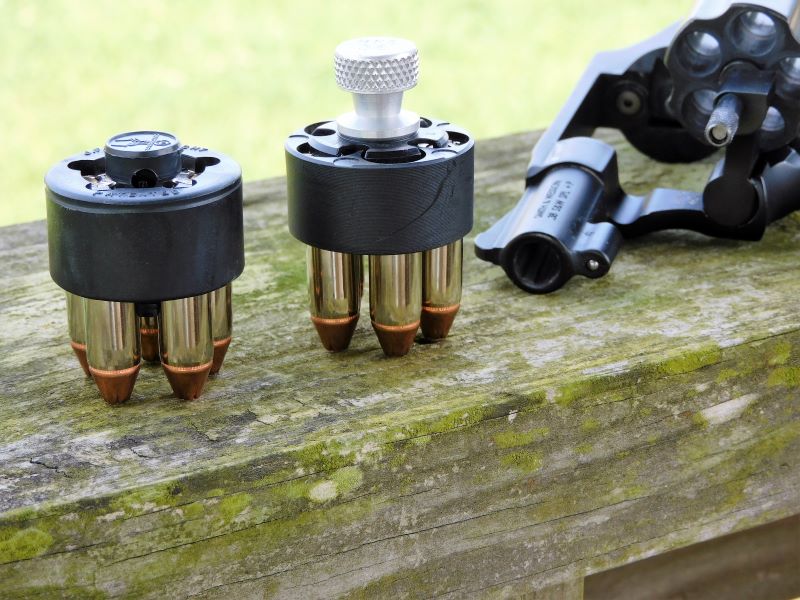There are a few common criticisms of modern double-action revolvers; chief among them is the slow reload. Autoloading pistols that are available now generally hold more ammunition, so the need to reload is less frequent. Even when required, reloading is as easy as hitting the magazine release button, fishing out a loaded magazine, and inserting it into the magwell. There are multiple reloading options with a revolver, but among the quickest and most durable reloading tools is the HKS speedloader. However, there are tradeoffs with every design. After years of shooting revolvers, I have developed a technique with the HKS loader that makes it faster and easier. Enter the Palm Technique.

The HKS Speedloader: A Quick Rundown
The exact origins of the HKS speedloader are difficult to nail down, but a similar design made by John Hunt was on the market in 1959. What is clear is that many loaders emerged in the 1960s. Their popularity rose in the aftermath of the Newhall Massacre in 1970. Police departments and state agencies began abandoning the practice of loading one round at a time, opting instead for devices that could load all rounds at once.
The HKS speedloader established itself as a quick and reliable loader. It uses a hard polymer body that holds the ammunition securely without any wiggle room. The ammo is held taught by a toothed gear hidden in the rear of the loader under a large knurled knob.

Loader Operation
To load ammunition into the loader, the knob is twisted clockwise, and the rounds are dropped in rim-first. Rotating the knob counterclockwise causes a tooth from the gear to lock under the rim of each round, holding it in place. Loading the revolver consists of lining bullet tips to chamber mouths and twisting the knob to release the rounds. Unlike other reloading methods, the geared tooth method held the rounds securely, while other loaders relied on garter springs that were less reliable. The teeth remain in place because the release knob is acted against by a spring-loaded ball detent that prevents accidental release if you bump the knob.
The security of the rounds is the best feature of the HKS loader. Another benefit is that HKS produces loaders for many different revolvers that are not made by other firms. Have an old 9-shot H&R revolver in .22? HKS has you covered. How about a .32 caliber J frame or a Charter Arms Bulldog in .44 Special? HKS has you covered. The only downside of the HKS is that it requires the user to turn the release knob in a separate step to release the round. Other loaders like the Safariland Comp. I to III release their rounds by either pressing the base of the loader against the cylinder or by hitting a release knob.
Making the Most of the HKS Loader
I have tried most commercially available loaders. Some are great for the range but not for carry. Others are serviceable but have their own quirks. My favorite variety is the Safariland Comp series, and the HKS is a close second. As it happens, speed loaders are compatible with specific revolver models, and I have accumulated a few revolvers for which only the HKS loader is available. Over my years of range shooting, I have gotten quick at releasing the knob of the loader, but it is a distinctly separate step that has to be accomplished. It is also a step that can ask a lot of your fingertips.
The Palm Technique
To alleviate both issues, I developed a palm technique for using the HKS loader that works similarly to the Safariland Comp III. The Comp III releases its rounds when you smack the release knob with the palm. Using the palm to strike is a basic fight or flight reflex, and anatomically, the palm has more surface area to accomplish a manipulative task.
To load the revolver, I open the revolver cylinder and smack the ejector rod to dump out the empty cases. After that, I simply go for the loader in my pocket. I palm the release knob and let my fingers encase the body of the loader past the bullet tips.

It helps me to seat my index finger between two rounds. This lets my fingers find the edge of the cylinder and line my index finger up with the flute of the cylinder. The rounds go in the cylinder without having to look down. Alternatively, find the technique that works best for you.

Once the loader is fixed to the cylinder, instead of pulling your hand away and going for the knob, hit the knob with the palm and give it a fractional clockwise turn. This brings loading with the HKS down to one fluid movement. Your hands do not have to leave the loader. And your fingers will not miss the knob or fail to release it because you are using the palm instead.
Final Thoughts
I initially discovered this technique while doing dry-fire practice and reloading drills using dummy ammunition. I bumped the release angularly, and my rounds released into the cylinder. On the clock with live ammunition, I could nominally reload my Smith & Wesson Model 686+ in five seconds using the traditional technique. Using the palm technique to release the loader shaved off .7 seconds for a 4.3-second load. The difference is just enough to be noticeable, but just about anyone can do it faster than me.
Although the HKS loader is not in vogue with PCC shooters, these bulletproof loaders are excellent for everyday carry or security work. After years of working with the palm technique, I came to think of the HKS as more of an equal to other loaders. They are durable and anything but slow.

